
|
|
|
|
|
|
Classic Bikes
Custom Bikes
Individual
Racing Bikes AJP
AJS
Aprilia
Ariel
Avinton / Wakan
Bajaj
Benelli
Beta
Bimota
BMW
Brough Superior
BRP Cam-Am
BSA
Buell / EBR
Bultaco
Cagiva
Campagna
CCM
CF Moto
Combat Motors
Derbi
Deus
Ducati
Excelsior
GASGAS
Ghezzi Brian
Gilera
GIMA
Harley Davidson
Hero
Highland
Honda
Horex
Husaberg
Husqvarna
Hyosung
Indian
Jawa
Kawasaki
KTM
KYMCO
Laverda
Lazareth
Magni
Maico
Mash
Matchless
Mondial
Moto Guzzi
Moto Morini
MV Agusta
MZ / MuZ
NCR
Norton
NSU
Paton
Peugeot
Piaggio
Revival Cycles
Roland Sands
Royal Enfield
Sachs
Sherco
Sunbeam
Suzuki
SWM
SYM
Triumph
TVS
Ural
Velocette
Vespa
Victory
Vincent
VOR
Voxan
Vyrus
Walt Siegl
Walz
Wrenchmonkees
Wunderlich
XTR / Radical
Yamaha
Zero
Video
Technical
Complete Manufacturer List
|
Ducati 906 Paso
|
| . |
|
Make Model |
Ducati 906 Paso |
|
Year |
1988 |
|
Engine |
Four stroke, 90° “L” twin cylinder, SOHC, desmodromic 2 valve per cylinder, belt driven |
|
Capacity |
904 cc / 55.2 cu in |
| Bore x Stroke | 92 x 68 mm |
| Compression Ratio | 9.2:1 |
| Cooling System | Liquid cooled |
|
Induction |
2x 44mm Weber 44 DCNF 116 carburetor |
|
Spark Plugs |
Champion RA6YC |
|
Ignition |
Marelli Digiplex variable advance |
|
Battery |
12V 19Ah |
|
Starting |
Electric |
|
Max Power |
64.7 kW / 88 hp @ 8000 rpm (at rear tyre: 56.8 kW / 77.2 hp @ 6500 rpm) |
|
Max Torque |
85 Nm / 8.7 kgf-m / 62.7 ft-lb @ 5000 rpm |
|
Clutch |
Dry, multiplate |
|
Transmission |
6 Speed |
|
Primary Drive Ratio |
2.000:1 (31/62) |
|
Gear Ratios |
1st 2.466 / 2nd / 1.764 / 3rd 1.350 / 4th 1.091 / 5th 0.958 / 6th 0.857:1 |
|
Final Drive Ratio |
2.666:1 (15/40) or 2.533 (15/38) |
|
Final Drive |
Chain |
|
Front Suspension |
42 mm Marzocchi M1R oil-dynamic fork provided with external adjusting system of the extension brake |
|
Rear Suspension |
Swinging fork with oil-dynamic adjustable mono shock, Marzocchi Duoshock |
|
Front Brakes |
2 x 280 mm Discs, 2 piston calipers |
|
Rear Brakes |
Single 270 mm disc, 1 piston caliper |
|
Front Tyre |
130/60-16 |
|
Rear Tyre |
160/60-16 |
|
Dimensions |
Length: 2032 mm / 80.0 in Width: 665 mm / 26.2 in Height: 1150 mm / 45.3 in |
|
Wheelbase |
1450 mm / 57.1 in |
|
Seat Height |
780 mm / 30.7 in |
|
Dry Weight |
205 kg / 452 lbs |
|
Wet Weight |
222 kg / 489 lbs |
|
Fuel Capacity |
22 L / 5.8 US gal / 4.8 Imp gal |
|
Consumption Average |
6.0 L/100km / 16.6 km/l / 39 US mpg / 47 Imp mpg |
|
Braking 60 km/h - 0 |
13.9 m / 45.6 ft |
|
Braking 100 km/h - 0 |
39.6 m / 129.9 ft |
|
Standing ¼ Mile |
12.1 sec / 173.3 km/h / 107.7 mph |
|
Top Speed |
213.4 km/h / 132.6 mph |
| Road Test | Moto.Journal 1989 |
| . |
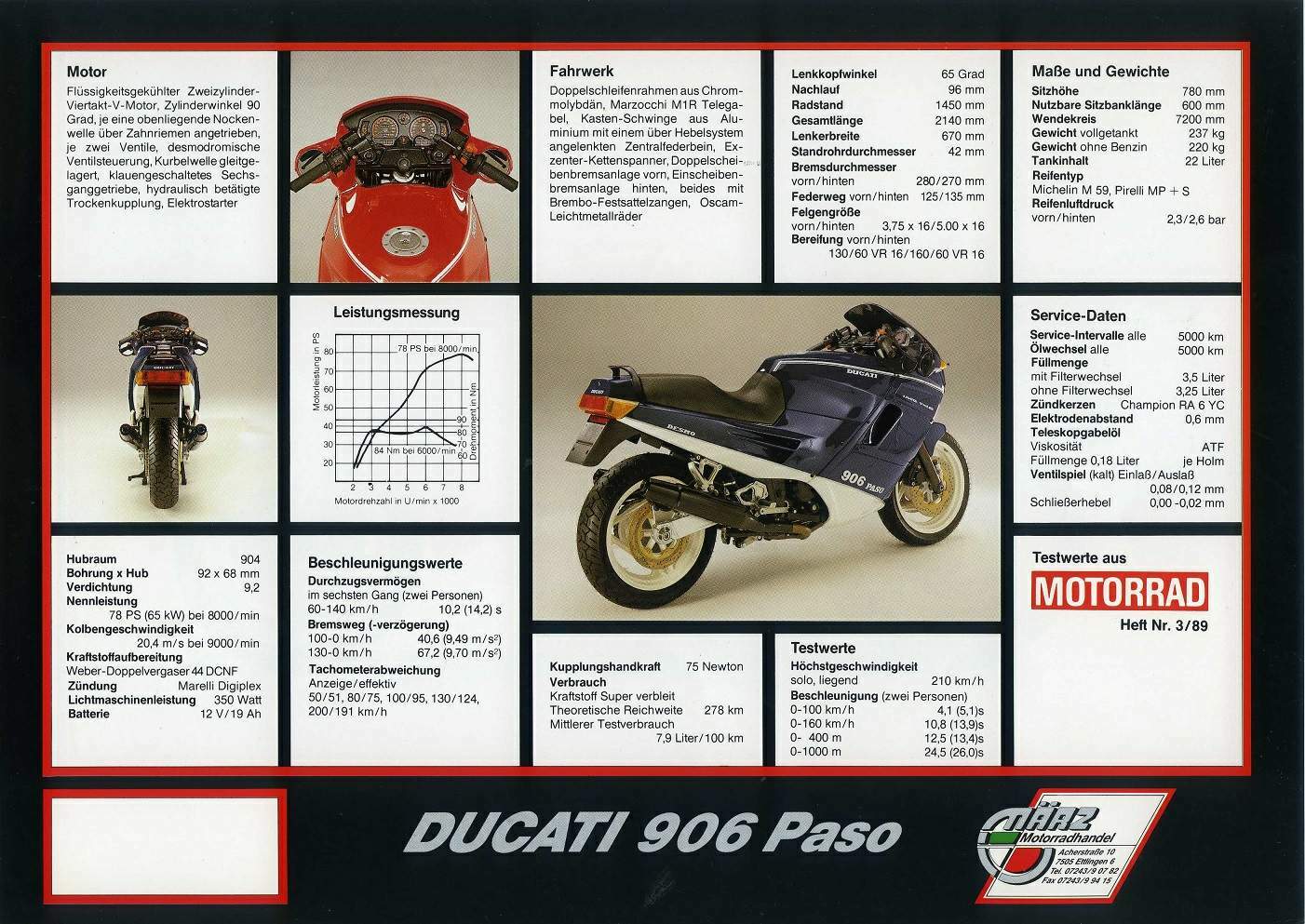
Introduced for 1989, the Paso 906 was a development of the preceding 750, one of the first models to emerge following Ducati's take-over by the Castiglioni family's Cagiva concern, and enjoyed a similarly improved level of equipment and build quality. The bigger Paso retained the same basic desmodromic v-twin engine architecture that had first appeared on the Pantah 500SL in 1979, but added water cooling to the package. Like the 750, the 906 featured a square-tube frame, hidden beneath all-enveloping bodywork penned by Massimo Tamburini, late of Bimota, while another 750 carry-over was the twin-choke Weber carburettor, chosen for its emissions friendliness. Suspension on the 906 was by Marzocchi at both ends (the 750 came with an Öhlins rear mono-shock) with brakes, as usual, supplied by Brembo. Both Pasos were fitted with the then fashionable 16" wheels, but only the 906 enjoyed the benefit of a sixth speed in the gearbox.
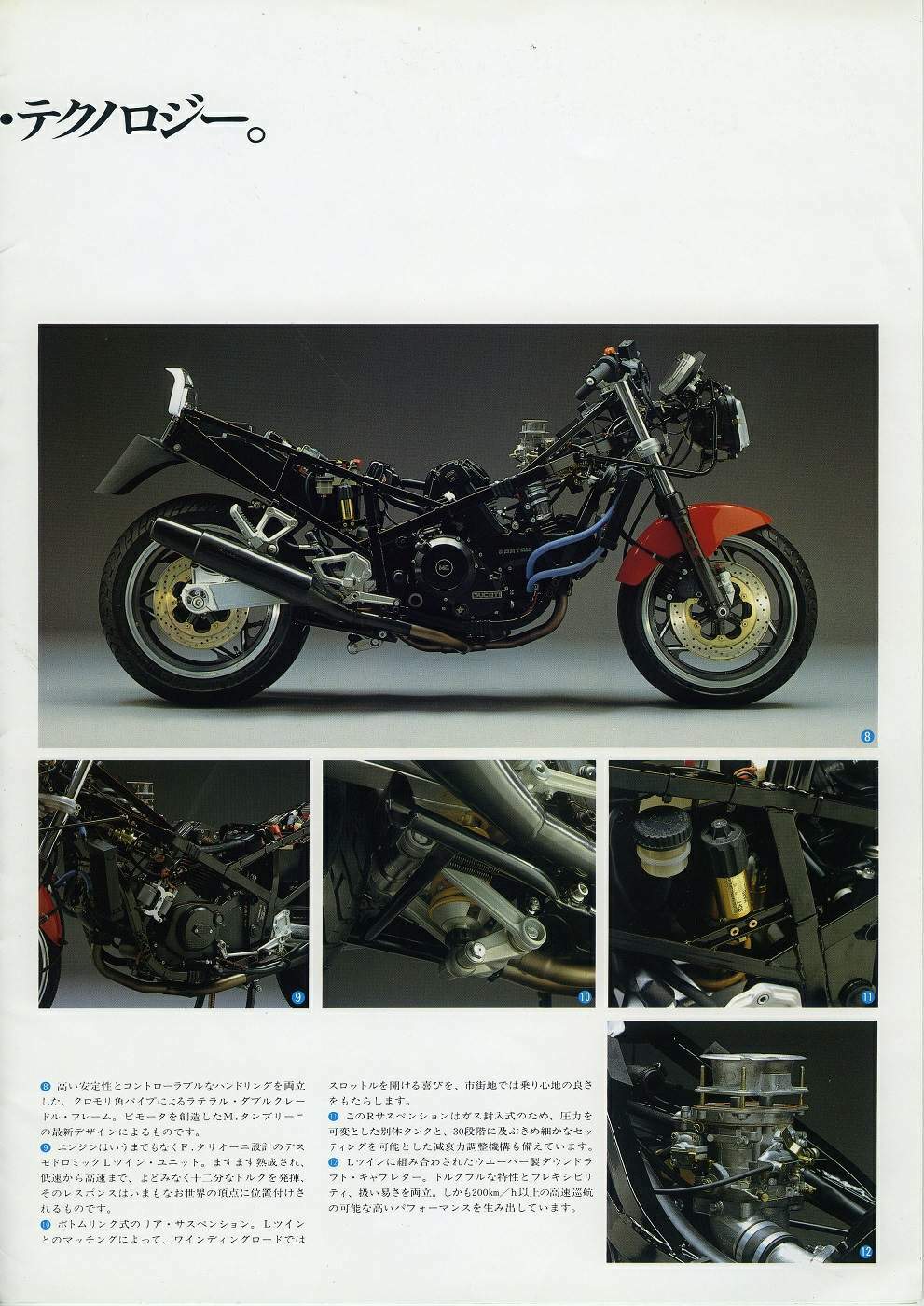
The Ducati Paso was introduced in 1986 with the slogan "Il nostro passato ha un grande futuro" (Our past has a great future). The name was in honour of racer Renzo Pasolini, nicknamed "Paso", who died on 20 May 1973 in an accident at the Monza race track during the Italian motorcycle Grand Prix (Gran Premio motociclistico d'Italia).
The Cagiva (from CAstiglioni GIovanni VArese) company, founded by the Castiglioni brothers, needed an engine – while Ducati, who had just been released from a difficult past of statutory public management (IRI), needed revenue.
Over a series of Italian style meetings/lunches in 1984, they agreed a deal for Ducati to supply engines to Cagiva – and then go out of the business of producing motorcycles. However, the Castiglioni brothers of Cagiva were eventually offered a deal to buy Ducati, subject to the Ducati name living on as an actual motorcycle product. On closure of the deal, Ducati engines were instantly installed in a number of Cagiva bikes, which included the Alazzurra and the Elefant enduro bike.
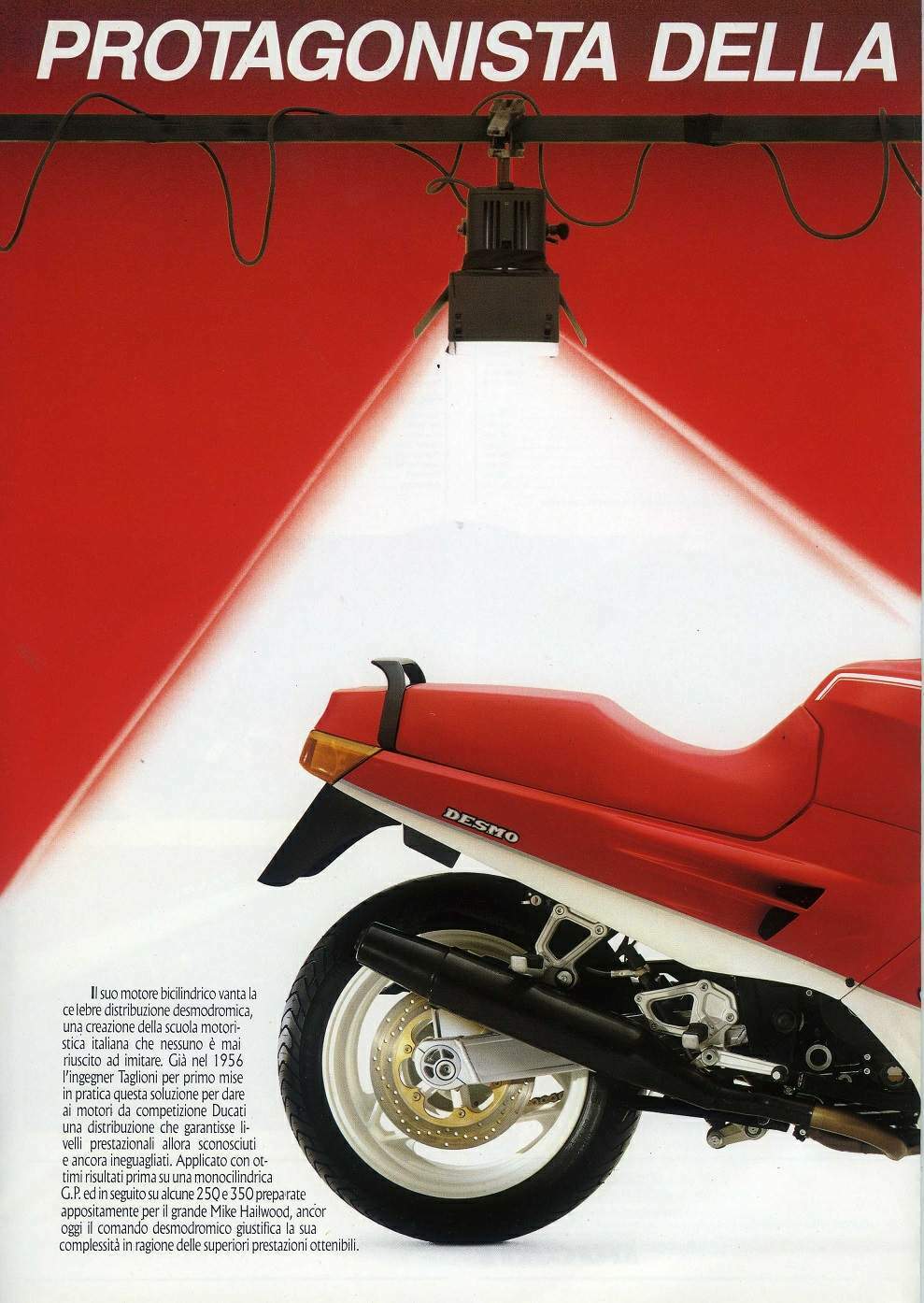
At the time of the takeover, due to its financial difficulties Ducati was in a state of suspended animation with regards to engineering development. By that time, the classic bevel drive V-twin, which was old and expensive to produce, had been replaced by the belt-drive Pantah, designed by Fabio Taglioni. The Pantah was already known to be a strong and capable engine, and known to deliver in the Ducati 750 F1.
The Pantah engine is equipped with desmodromic valves and has been constantly developed up to the present day. And around it Cagiva wanted a Ducati motorcycle unlike any other, that showed the world both Ducati's capabilities, and where it would go in the future.
The design challenge
The challenge consisted in constructing a bike with innovative technical characteristics and image to fight the intense Japanese competition. To undertake the ambitious objective Ducati hired Massimo Tamburini, co-founder of Bimota. Tamburini would go on to design the Ducati 916 and MV Agusta F4 series, included in the Guggenheim Museum's The Art of the Motorcycle exhibition of 1988–1999, and the MV Agusta Brutale series.
Tamburini decided to streamline the bike and its 750cc motor in a close-fitting integral fairing that hid all mechanical parts - one of the first motorcycles to do this, along with the Honda CBR Hurricane series, introduced the same year. He also reversed the rear cylinder head in order to meet emissions and noise restrictions abroad. The Paso 750 was equipped with latest-generation technical features: square frame tubes made in chromoly steel, rear aluminium swingarm with progressive suspension, 16-inch wheels with radial tires, air-and-oil cooled engine, electronic ignition and a comprehensive dashboard.
The finished design was christened the Paso 750 and debuted at the 1985 Milan Motorcycle Show, along with a 350 cc version that was never produced. Although initially offered only in red, by 1988 it was offered in red, blue and pearl white. Ducati and Cagiva had hopes that the new machine would redefine sports touring motorcycling and complement their sportsbike line, especially in the American market.
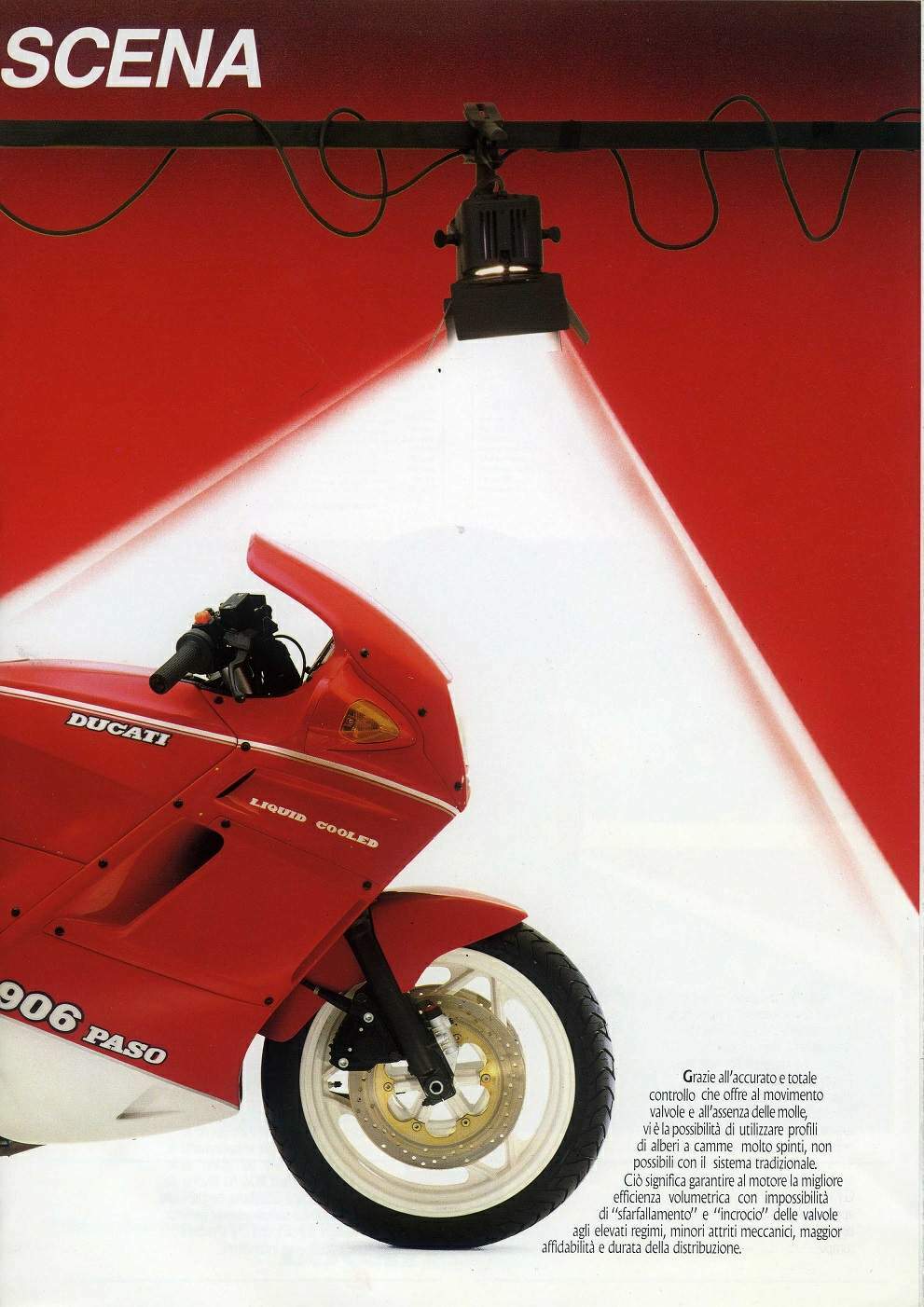
Sales and development
The commercial success didn't come however, and worldwide the Paso 750 only sold 4,863 units between its introduction in 1986 and 1988. Only 700 were imported into the United States in 1987. The Paso was more expensive and had lower performance (72.5 hp and 210 km/h top speed) than its competitors, and had some reliability and rideability problems with the electrical and fuel systems, due to the use of an automotive Weber carburetor, which was ill-suited to a small-capacity motorcycle engine.
In 1989 the Paso 906 was introduced to replace the 750, with a six-speed gearbox, a 904 cc engine which provided 88 hp and a 220 km/h top speed. The bike still had the same automotive carburetor and unreliable electrical system, but its greatest development was the incorporation of liquid cooling. 1,802 Paso 906's were built between 1988 and 1989.
After further development, the final version of the design came in 1991 with the 907 i.e. (iniezione elettronica); now without the name "Paso". The engine remained liquid-cooled and the carburetor was replaced by the most modern Weber-Marelli IAW 043 system that integrated ignition and electronic fuel injection, which transformed the rideability of the bike. Power increased to 90 hp and top speed to 230 km/h. The wheels were changed to 17 inches, giving the bike more stability.
Despite these advances sales of this model remained sluggish, and when production ceased in 1992 only 2,303 907IE's had been built.
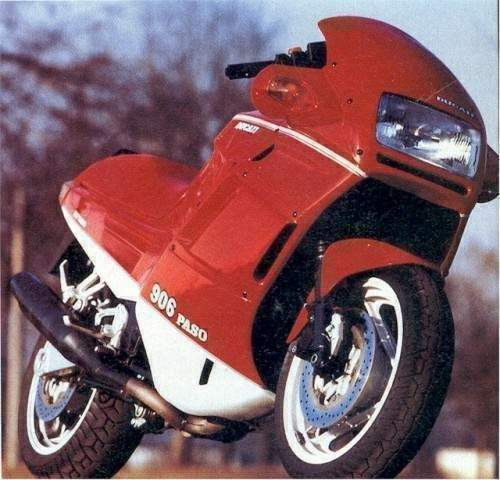
|
Any corrections or more information on these motorcycles will be kindly appreciated. |